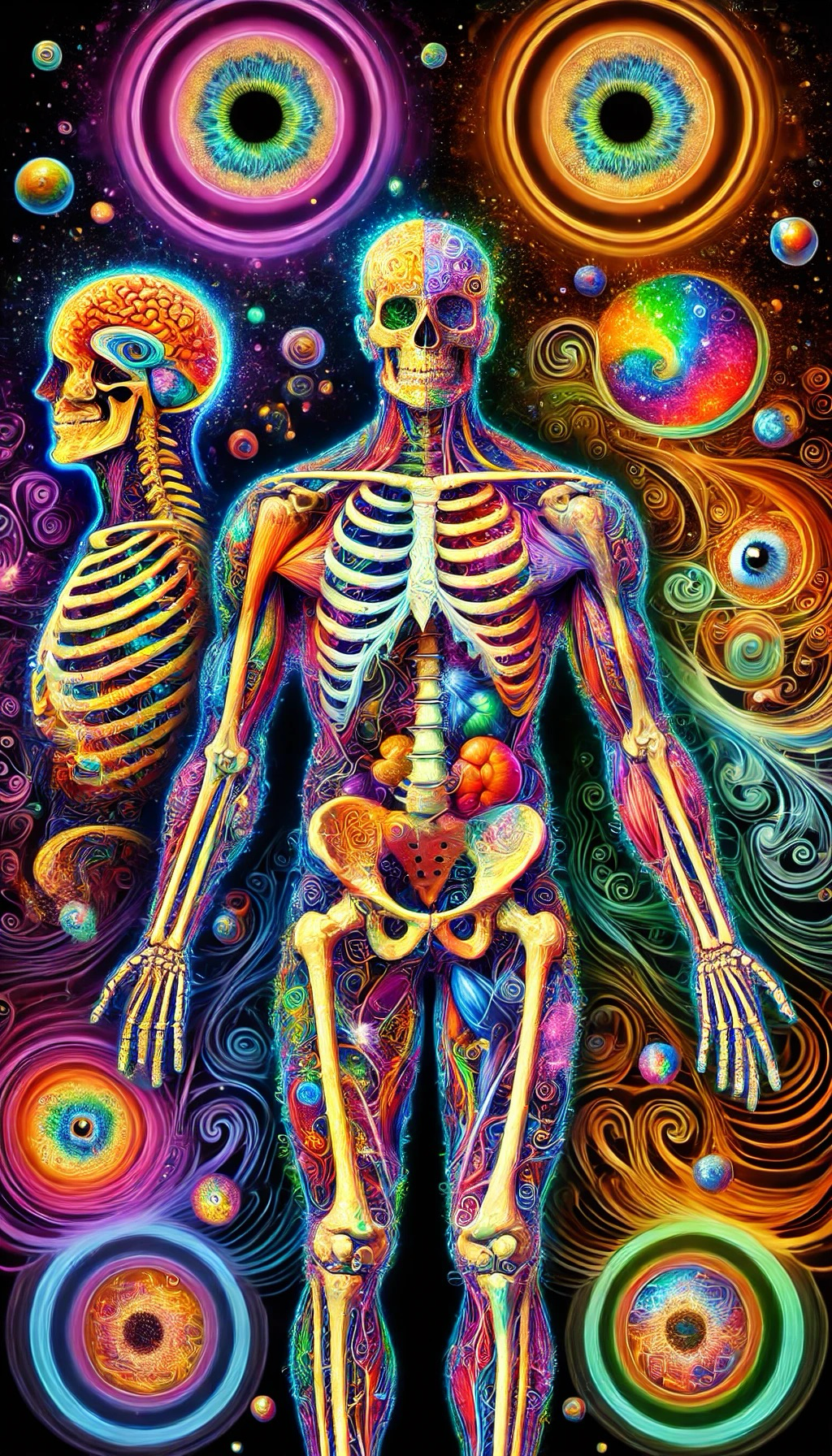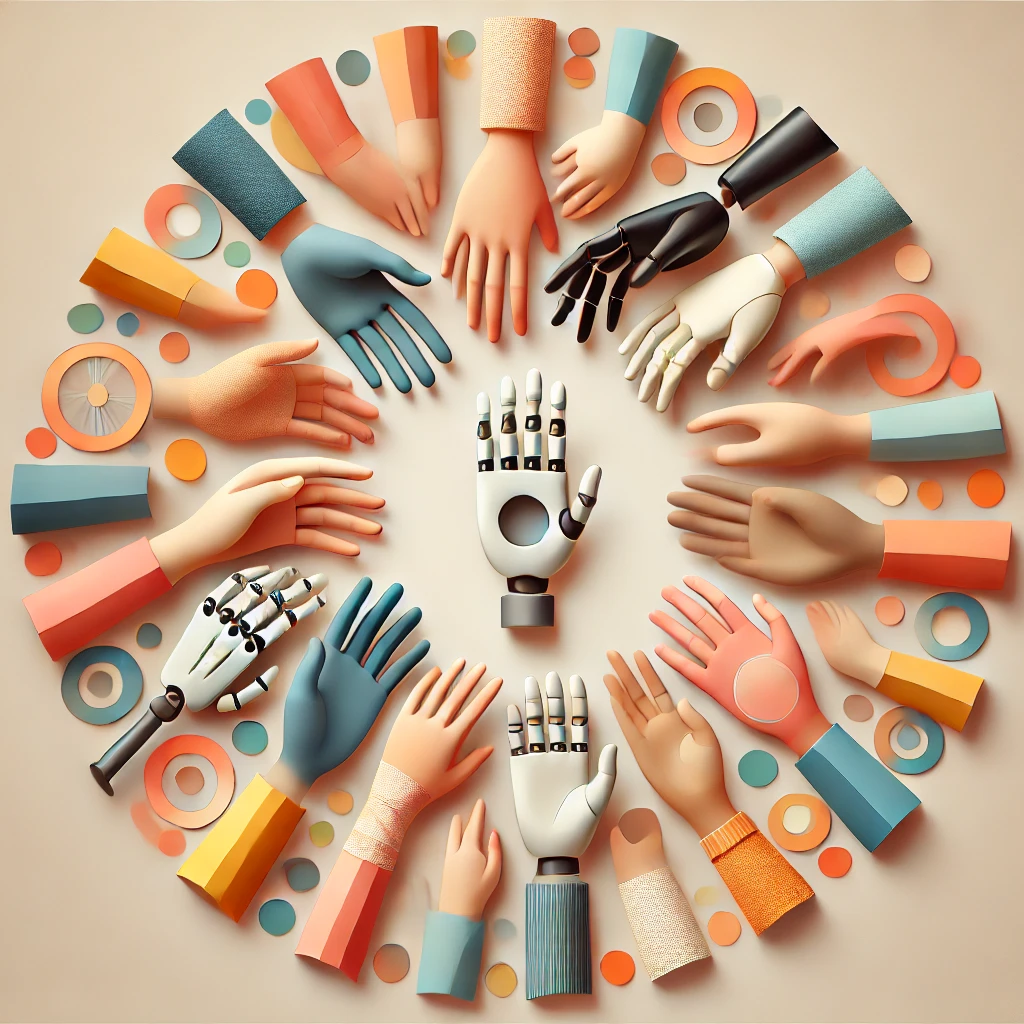Quill & Chill
The Two Sides of Ecstasy: A Look into the Dialectical Nature of Orgasms

Orgasms are the grand finale of our sexual symphony, but there's so much more to them than just a fireworks show. To really get the most out of these moments of pure bliss, we need to understand their dual nature—the fascinating dance between the physical and psychological. Buckle up as we dive into the thrilling world of orgasms and uncover what makes them tick.
❣ What is an Orgasm? ❣
An orgasm is that ultimate moment of sexual excitement that makes us feel like we're floating on cloud nine. It's the crescendo of pleasure, with rhythmic contractions, a racing heart, and a rush of endorphins that leave us feeling euphoric. But orgasms aren't just about feeling good—they're essential for sexual health, emotional connection, and overall well-being. Let's take a closer look at the magic behind the climax.
❣ The Physical Side of Orgasms ❣
The journey to orgasm is like an exhilarating roller coaster ride, with your body gearing up for the big finale. Arousal kicks things off, sending blood rushing to your most sensitive spots and heightening every sensation. As you get closer to the peak, your body releases a cocktail of feel-good hormones like oxytocin and dopamine, which amplify pleasure and create that irresistible bond with your partner.
Physiological Details
Behind the scenes, your autonomic nervous system is hard at work. During arousal, the sympathetic nervous system ramps up, increasing your heart rate, blood pressure, and respiration. Just as you're about to climax, the parasympathetic nervous system takes the reins, orchestrating those mind-blowing muscle contractions and releasing all that built-up tension. Orgasms originate from nerve plexuses such as the sacral plexus, which plays a critical role in the sensory and motor functions involved in sexual pleasure.
Biological Details
Your brain, nerves, and genital organs are the all-star team making orgasms happen. Sensory signals from your most sensitive areas travel to your brain's pleasure centers, triggering a cascade of neurotransmitters that turn up the pleasure dial.
Biochemical Details
Orgasms unleash a flood of chemicals that create that blissful feeling. Endorphins, the body's natural painkillers, sweep you into a state of euphoria and relaxation. Oxytocin, the "love hormone," deepens emotional bonds, while dopamine heightens feelings of reward and pleasure.
The culmination of these processes is the orgasm, marked by muscle contractions and a release of built-up sexual tension. This physical release can provide numerous benefits, such as stress relief, improved sleep, and even pain relief due to the endorphin surge. Understanding these physical components helps us appreciate the body's role in creating orgasmic pleasure.
The Psychological Side of Orgasms
Orgasms are as much a mental trip as they are a physical one. Your state of mind plays a starring role in whether you reach that peak. Stress, anxiety, and mental blocks can all throw a wrench in the works, while a relaxed, positive mindset can make the journey smoother and more enjoyable.
Emotionally, orgasms boost your mood and strengthen your connection with your partner. The rush of oxytocin released during orgasm enhances intimacy and trust, making those moments of ecstasy even more special. It's clear that a healthy mind is just as crucial as a responsive body for an amazing orgasmic experience.
❣ The Dialectical Nature: Interplay Between Physical and Psychological Aspects ❣
The physical and psychological aspects of orgasms are like two dance partners, each influencing the other's moves. Physical tension and release can trigger powerful emotional responses, while a positive mental state can amplify physical sensations. This dynamic interplay makes every orgasm a unique and personal experience.
Imagine you're feeling stressed and anxious—these emotions can create barriers to achieving orgasm. But with relaxation techniques and open communication with your partner, you can overcome these hurdles. Conversely, engaging in physical activities that boost arousal can lift your spirits and reduce stress, showcasing the beautiful balance between body and mind.
❣ Shame and Orgasms: Breaking the Taboo ❣
For many, achieving orgasm can come with an unexpected side dish of shame. This can stem from cultural or societal taboos, personal insecurities, or past experiences. It's crucial to recognize that orgasms are natural, healthy, and something to be celebrated.
Letting go of shame involves embracing your body's natural responses and understanding that pleasure is a fundamental part of human experience. Open conversations with your partner, educating yourself about sexual health, and challenging societal norms can help dismantle these barriers. Remember, your pleasure is your right, and there's no shame in celebrating it.
❣ Pleasure vs. Orgasm: Understanding the Difference ❣
It's important to note that pleasure and orgasm are not synonymous. Pleasure encompasses a wide range of enjoyable sensations and experiences that can occur throughout sexual activity. Orgasms are a specific, intense peak of pleasure, but they are not the only goal or measure of a satisfying sexual experience.
Pleasure can be found in the build-up, the connection with your partner, the exploration of each other's bodies, and the emotional intimacy shared. Focusing solely on achieving orgasm can sometimes detract from the overall experience. Embrace all forms of pleasure and remember that every step of the journey can be deeply fulfilling.
❣ Male vs. Female Responses ❣
While orgasms share common elements across genders, there are notable differences in male and female responses. Studies using brain imaging during climax reveal that both men and women show increased activity in areas associated with reward and pleasure, but there are distinct variations in how these experiences unfold.
Male Response For men, orgasm typically follows a linear progression. The arousal phase leads to plateau, climax, and resolution. The release of semen during ejaculation is often the marker of male orgasm, followed by a refractory period during which it's difficult to achieve another orgasm immediately.
Female Response Women, on the other hand, can experience multiple orgasms in succession without a refractory period. The female sexual response cycle is often more complex and can vary significantly among individuals. Brain studies show heightened activity in the prefrontal cortex, which is associated with emotional regulation and consciousness, indicating a more integrated experience of physical and emotional pleasure.
❣ Stages of Orgasm ❣
Orgasm is often thought of as a singular event, but it actually consists of multiple stages, each contributing to the overall experience. Let's explore these eight stages to gain a deeper understanding of what happens during an orgasm.
1. Excitement
This is the initial stage where sexual arousal begins. Physical and emotional stimulation increases blood flow to the genitals, causing them to swell. Your heart rate quickens, and your skin might become flushed.
2. Plateau
In the plateau stage, the changes that began in the excitement phase intensify. Breathing becomes more rapid, and muscle tension increases. This phase can last from a few seconds to several minutes.
3. Sensation
During this stage, heightened sensitivity leads to an increase in pleasurable sensations. Every touch feels more intense, and the body is preparing for the climax.
4. Pre-Orgasm
This stage is characterized by a peak in sexual tension. The body is on the brink of orgasm, with muscles contracting rhythmically as they prepare for release.
5. Orgasm
The climax is marked by a series of involuntary muscle contractions. For women, this includes the vaginal muscles, while for men, it involves the muscles around the penis. Both sexes experience a rush of endorphins and a peak in pleasure.
6. Climax
Often used interchangeably with orgasm, the climax is the peak of sexual pleasure. It’s the point at which the pleasurable sensations reach their highest intensity.
7. Resolution
In the resolution stage, the body gradually returns to its normal state. Heart rate and breathing slow down, and the muscles relax. For many, this is a period of relaxation and satisfaction.
8. Refractory
The final stage is the refractory period, during which the body recovers and becomes temporarily unresponsive to further sexual stimulation. This period varies greatly between individuals.
Understanding Your Body
Recognizing these stages can help you understand your own sexual response cycle and communicate better with your partner. Everyone's experience of these stages can be different, so it's essential to explore what works best for you.
Enhancing Your Experience
Experimenting with different forms of stimulation, positions, and techniques can help you and your partner fully enjoy each stage of the orgasm. Open communication about what feels good and what doesn’t can lead to more satisfying sexual experiences.
❣ Types of Orgasms ❣
Orgasms are not one-size-fits-all; they can vary greatly depending on the individual and the context.
Here are some common types:
Multiple Orgasms Some people, particularly women, can experience multiple orgasms in a single sexual encounter. This means having several orgasms one after another without a refractory period, allowing for extended periods of pleasure.
Stacked Orgasms Stacked orgasms occur when the buildup of pleasure and tension leads to successive peaks of orgasmic release. Unlike multiple orgasms, stacked orgasms happen in rapid succession, creating an intense and prolonged orgasmic experience.
Different Areas of the Body Orgasms can also be triggered from various parts of the body, thanks to the brain's neuroplasticity.
These include:
- Clitoral Orgasms: Stimulated by the clitoris, the most common type for women.
- Vaginal Orgasms: Resulting from stimulation of the vaginal walls, often linked to the G-spot.
- G-spot Orgasms: Achieved through stimulation of the G-spot, located on the anterior wall of the vagina, producing deep, intense sensations.
- A-spot Orgasms: Stemming from stimulation of the A-spot (anterior fornix erogenous zone), located deeper in the vagina, near the cervix, which can result in a uniquely satisfying orgasm.
- Anal Orgasms: Achieved through anal stimulation, which can be pleasurable due to the density of nerve endings.
- Nipple Orgasms: Some people can experience orgasms through intense nipple stimulation.
- Full-Body Orgasms: These are often reported in practices like tantric sex, where the sensation spreads throughout the body.
❣ Disability and Orgasms: Embracing Neuroplasticity and BDSM ❣
For those who face physical disabilities, achieving orgasm can present unique challenges. However, understanding neuroplasticity—the brain's ability to adapt and form new neural connections—can open doors to new possibilities. Practices such as BDSM (bondage, discipline, sadism, and masochism) can also introduce alternative pathways to pleasure, providing different sensory experiences that might help achieve orgasm.
Neuroplasticity allows the brain to find new ways to experience pleasure, even if traditional methods are challenging. By exploring different forms of sexual expression and sensation, individuals with disabilities can find fulfilling ways to experience orgasmic pleasure.
❣ Trauma and Orgasms: Overcoming Barriers ❣
Trauma, whether physical, emotional, or sexual, can significantly impact one's ability to achieve orgasm. Survivors of trauma may experience anxiety, flashbacks, or dissociation during sexual activity, creating barriers to pleasure and orgasm.
Tips for Moving Past Trauma:
- Therapy: Seeking the help of a therapist specializing in trauma can provide a safe space to work through past experiences and their impact on your sexual health.
- Communication: Open and honest communication with your partner about your needs, boundaries, and triggers is crucial.
- Self-Exploration: Masturbation can be a healing way to reconnect with your body and discover what feels good without the pressure of performing for a partner.
- Mindfulness and Relaxation Techniques: Practices such as meditation, deep breathing, and yoga can help manage anxiety and create a relaxed state conducive to sexual pleasure.
- Establishing Safety and Trust: Building a sense of safety and trust with your partner can create a supportive environment where you feel comfortable exploring your sexuality.
❣ Pharmacological Influences on Orgasms ❣
Medications can have significant effects on sexual function, including the ability to achieve orgasm. Some medications can enhance sexual pleasure and facilitate orgasm, while others can inhibit these experiences.
Medications That Enhance Orgasms:
- Phosphodiesterase Inhibitors: Drugs like sildenafil (Viagra) and tadalafil (Cialis) can improve blood flow to the genital area, enhancing arousal and the likelihood of orgasm in men and women.
- Hormone Therapy: Estrogen and testosterone therapies can improve sexual function in individuals experiencing hormonal imbalances. However, it is important to note that estrogen therapy is typically prescribed to women and should not be used by men seeking to enhance orgasm. Misuse can lead to serious health issues. Women taking estrogen therapy should do so under medical supervision, as it can have significant impacts on reproductive health, including increased risks of certain cancers.
- Bupropion: An antidepressant that has been found to have fewer sexual side effects and may even enhance sexual desire and orgasm in some individuals.
Medications That Inhibit Orgasms:
- Selective Serotonin Reuptake Inhibitors (SSRIs): Commonly prescribed for depression and anxiety, SSRIs like fluoxetine (Prozac) and sertraline (Zoloft) can delay or inhibit orgasm.
- Antipsychotics: Medications like risperidone (Risperdal) and olanzapine (Zyprexa) can affect sexual function, including the ability to achieve orgasm.
- Beta-blockers: Used for hypertension and anxiety, beta-blockers like propranolol can decrease sexual desire and inhibit orgasm.
Managing Medication Side Effects:
- Consult Your Doctor: If you experience sexual side effects, talk to your healthcare provider. They may adjust your dosage or switch you to a different medication.
- Timing: Some individuals find that adjusting the timing of their medication can help reduce sexual side effects.
- Combining Therapies: In some cases, adding a medication like bupropion to counteract the sexual side effects of another drug may be beneficial.
❣ Challenges and Barriers to Achieving Orgasm ❣
Despite the potential for profound pleasure, many individuals face challenges in achieving orgasm. Common issues include stress, anxiety, medical conditions, and the influence of societal norms and misconceptions. These barriers can disrupt the delicate balance between physical and psychological factors.
To overcome these challenges, it is essential to address both sides of the equation. Techniques such as mindfulness, stress reduction, and open communication with partners can help mitigate psychological barriers. Understanding one's body, exploring different forms of sexual expression, and seeking medical advice when necessary can also enhance physical readiness.
❣ Enhancing Orgasmic Experiences ❣
Want to take your orgasmic experiences to the next level? It starts with nurturing both your body and mind. Physically, stay active, eat well, and get plenty of rest. Try new things in the bedroom, like tantric practices or mindful sex, to heighten your sensations.
Mentally, a positive mindset and stress reduction are key. Practice meditation, seek therapy if needed, and talk openly with your partner about what you enjoy and desire. By embracing vulnerability and exploring together, you can create deeper emotional connections and more fulfilling sexual experiences.
Orgasms are a dazzling dance between the physical and psychological, each enhancing the other to create moments of pure ecstasy. By understanding and embracing both sides, you can enhance your sexual health and enjoy more satisfying experiences. Remember, exploring and understanding your own body and mind is the key to unlocking the true power of orgasms. And while we celebrate the joy of orgasms, it's essential to recognize that they are not the end-all-be-all of intimacy. The journey of pleasure, connection, and emotional intimacy is equally, if not more, important.
❣ Disclaimer ❣
While this blog celebrates the joys of orgasms and aims to enhance your understanding, it's important to recognize that orgasms are not the ultimate goal of intimacy. Pleasure, connection, and emotional intimacy are equally valuable and essential aspects of a fulfilling sexual experience.
❣
More Sexy Science
❣
The field of neuroscience has provided fascinating insights into the differences between male and female brains during orgasm. These differences can be observed through brain activity patterns, hormone influences, and structural variances. These studies provide comprehensive insights into the neurobiological underpinnings of orgasm in men and women, highlighting both differences and similarities. Understanding these differences is crucial for advancing sexual health and therapy. Here, we summarize key studies that explore these differences, shedding light on the complex interplay between gender, brain function, and sexual pleasure.
Brain Activity During Orgasm in Women: This study used fMRI to analyze brain activity in women during orgasm. Results showed significant activation in brain regions associated with pleasure and reward, including the hypothalamus and nucleus accumbens.
Holstege, G., Georgiadis, J. R., Paans, A. M., Meiners, L. C., van der Graaf, F. H., & Reinders, A. A. (2003). Brain activation during human male ejaculation. Journal of Neuroscience, 23(27), 9185-9193.
Comparing Male and Female Brain Activation: Georgiadis et al. (2006) used PET scans to compare male and female brain activation during orgasm, finding distinct activation patterns in the amygdala and hypothalamus.
Georgiadis, J. R., Kortekaas, R., Kuipers, R., Nieuwenburg, A., Pruim, J., Reinders, A. A., & Holstege, G. (2006). Regional cerebral blood flow changes associated with clitorally induced orgasm in healthy women. European Journal of Neuroscience, 24(11), 3305- 3316.
Neurophysiology of Orgasm: This review highlighted the role of central melanocortin-4 receptors and oxytocin in sexual responses, providing insights into the neural mechanisms underlying orgasm in both sexes.
Gelez, H., Poirier, S., Facchinetti, P., Allers, K. A., Wayman, C., & Alexandre, L. (2010). Neuroanatomical evidence for a role of central melanocortin-4 receptors and oxytocin in the efferent control of the rodent clitoris and vagina. Journal of Sexual Medicine, 7(6), 2056-2067.
First Brainwide Map of Sex and Intimacy: This study mapped brain activity in prairie voles during mating and bonding, showing nearly identical patterns of brain activity in males and females, suggesting similar mechanisms might be at play in humans.
Phelps, S. M., Gustison, M. L., Muñoz-Castañeda, R., & Osten, P. (2024). First brainwide map shows how sex and intimacy rewire the brain. eLife.
Sexual Dimorphism in Brain Anatomy: This review discussed structural differences in male and female brains, such as brain volume and regional brain volumes, which may underlie functional differences during orgasm.
Cahill, L. (2006). Why sex matters for neuroscience. Nature Reviews Neuroscience, 7(6), 477-484.
Differences in Cardiovascular Responses During Orgasm: A study examining cardiovascular responses in the brain during orgasm found distinct activation patterns in men and women, particularly in the insula and other areas linked to cardiovascular control.
Macey, P. M., & Harper, R. M. (2008). Cardiovascular responses during Valsalva maneuver in obstructive sleep apnea and control subjects. Frontiers in Neurology.
Neuroimaging of Orgasm in Men: This study used fMRI to observe brain activity in men during orgasm, noting significant activity in areas associated with pleasure and reward, including the ventral tegmental area and prefrontal cortex.
Holstege, G., & Georgiadis, J. R. (2009). The neurophysiology of orgasm. Current Sexual Health Reports, 1(1), 18-22.
Role of Hormones in Orgasm: Research on the role of hormones such as testosterone and estrogen showed that these hormones influence brain activity during orgasm differently in men and women.
Pfaus, J. G., & Heeb, M. M. (1997). Implications of immediate-early gene induction in the brain following sexual stimulation of female and male rodents.
Brain Research Bulletin, 44(4), 397-407.
Functional MRI Study of Female Orgasm: This study demonstrated that female orgasm is associated with widespread activation across multiple brain regions, including the cerebellum and frontal lobes.
Komisaruk, B. R., & Whipple, B. (2005). Functional MRI of the brain during orgasm in women. Annual Review of Sex Research, 16(1),62-86.
Brain Mechanisms of Sexual Pleasure: This comprehensive review explored various brain mechanisms involved in sexual pleasure and orgasm, highlighting differences in activation patterns between men and women.
Pfaus, J. G. (2009). Pathways of sexual desire. Journal of Sexual Medicine, 6(6), 1506-1533.
❣FAQs❣
1. What are the common barriers to achieving orgasm? Common barriers include stress, anxiety, medical conditions, and societal misconceptions. Addressing these issues through relaxation techniques, medical consultation, and open communication with partners can help overcome them.
2. How can I improve my chances of having an orgasm? Focus on both physical and psychological well-being. Engage in regular exercise, maintain a healthy diet, practice mindfulness, and communicate openly with your partner about your desires and boundaries.
3. How do orgasms benefit overall health? Orgasms provide numerous benefits, including stress relief, improved sleep, pain relief, enhanced mood, and strengthened emotional bonds with partners.
4. What role does the mind play in achieving orgasm? The mind is crucial in achieving orgasm. A positive psychological state can enhance physical sensations, while stress and anxiety can hinder the ability to reach climax.
5. How can I enhance emotional intimacy with my partner during sex? Open communication, vulnerability, and mutual exploration of desires and boundaries can strengthen emotional intimacy. Practicing mindfulness and being present in the moment can also deepen the connection.











